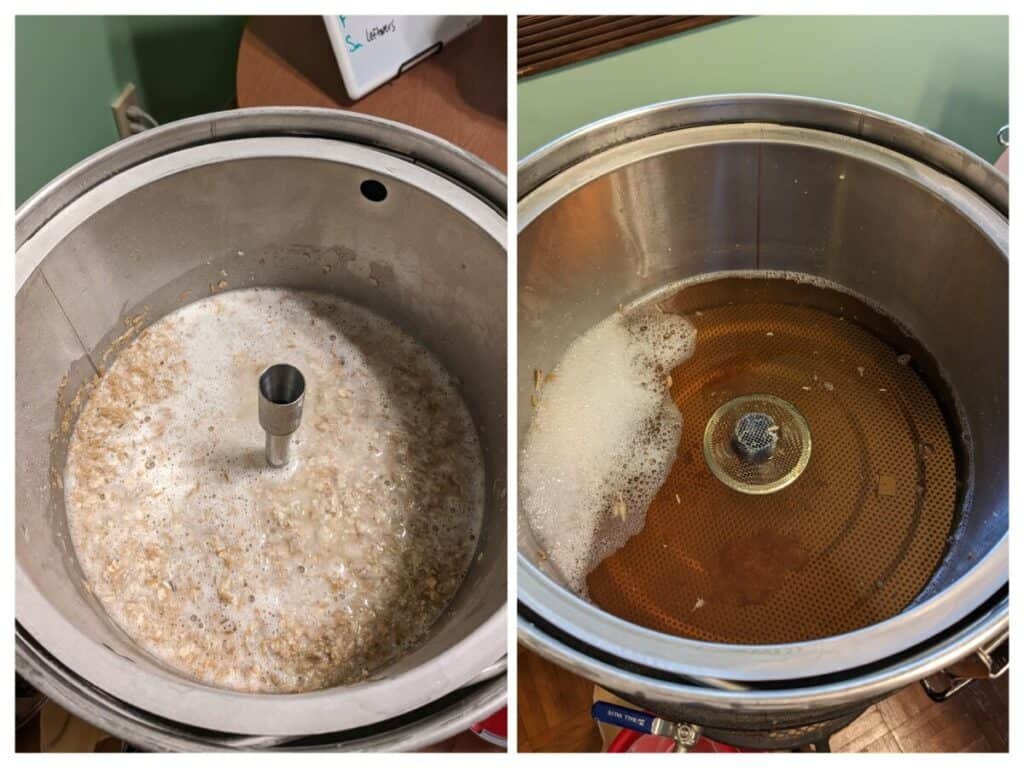What is Mash?
Mashing is the process of soaking malted grain in hot water to extract sugars, starches, and proteins.
Here’s an excerpt from a previous article that provides a quick reference to various mash steps. Check out “Do the Two-Step: Let’s Mash It Up” for deeper reading.
If you’re new to all grain brewing, a single infusion mash, or a mash that is held at the same temperature throughout the mashing process, is going to be an excellent starting place. Especially with today’s modern malts, complicated mash step regimes are a thing of the past.
TYPICAL MASHING TECHNIQUES FOR HOMEBREWERS
| Mash Profile | Example Mash Steps |
| Single Infusion | 65 °C or 67 °C (149 °F to 153 °F) for 60 minutes |
| Two-Step | 62 °C (144 °F) for 30 minutes 71 °C (160 °F) for 30 minutes |
| Three-Steps, Mister! | 50 °C (122 °F) for 30 minutes 60 °C (140 °F) for 30 minutes 70 °C (158 °F) for 30 minutes |
| Hochkurz | 62 °C (144 °F) for 30 minutes 71 °C (160 °F) for 30 minutes 77 °C (171 °F) for 10 minutes |
| Medium Body | 65 °C (149 °F) for 60 minutes 75 °C (167 °F) for 10 minutes |
| Dry Finish | 60 °C (140 °F) for 30 minutes 70 °C (158 °F) for 30 minutes 75 °C (167 °F) for 10 minutes |
Single Infusion Mash
Since highly modified malts are widely available, many brewers opt for a simplified mash: the single infusion mash. The mash is usually held between 63 °C and 68 °C which allows β-amylase and α-amylase to work together at converting starch into sugar.
The Two-Step
An alternative to the single infusion mash is to have two rests to allow β-amylase and α-amylase to work near their optimal temperature.
The mash is held at 62 °C for 30 to 45 minutes before the temperature is raised to 71 °C for 30 to 45 minutes.
This type of step mash procedure promotes a highly fermentable wort.
Give Me Three Steps, Mister
If you were using an under-modified malt like floor-malted barley, performing a step mash that incorporates a protein rest before the saccharification rest would be beneficial to break down some of the larger proteins in the malt.
A typical profile for brewing a European-styler pilsner would have a rest at 50 °C for 20 to 30 minutes, then heated to 60 °C for 30 minutes, and finally another rest at 70 °C for 30 minutes.
As mentioned before, if using highly modified malts, the protein rest is largely seen as unnecessary due to modern malting technology and high protein modification of malts.
Maximum Fermentability
A modification of the two-step mash profile mentioned earlier, this type of step mash process is called Hochkurz; hoch means “high” and kurz means “fast”. The Hochkurz mash is held at 62 °C for 30 to 45 minutes before the temperature is raised to 71 °C for 30 to 45 minutes. The mash is then heated to 77 °C for a 10 minute mashout step.
CONCLUSIONS
There are many tools available to brewers to dial in on the quality of their wort. And there isn’t just one right way to brew beer.
A single infusion mash is simple. But if your brewing setup makes adjusting the temperature of the wort practical during the mash, step mashing is worth exploring.

